Valparaiso: Art in the Street
29 January, 2008, 12:10 am in "Chile"
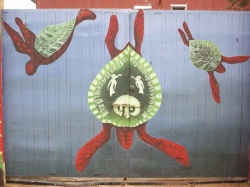 Though the main draw of Alegre and Concepcion Hills are the historic buildings, modern times have brought artists, filling the area with galleries and cafes. However, what really makes the streets come to life is how the past and present are joined through street art.
Though the main draw of Alegre and Concepcion Hills are the historic buildings, modern times have brought artists, filling the area with galleries and cafes. However, what really makes the streets come to life is how the past and present are joined through street art. The hills are full of graffiti art, or rather "underground" murals. Though there is an unfortunate amount of tagging (something I feel is the spray paint equivalent of dogs peeing on things to mark their territory), most of the street art is beautiful and original murals across walls that were originally boring gray concrete.

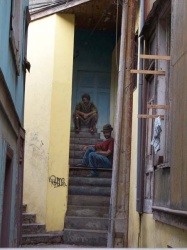
By removing these spots of contemporary city gray and replacing them with whimsical, colorful murals, the artists add more color to the neighborhood, perhaps carrying on the traditions of the original house owners who built their houses and painted them to fill the neighborhood with a garden of color: blooming against the gray coastal fog.
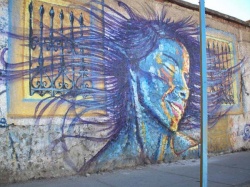
There are also some stencil art, my favorite of which was a monkey head wearing headphones with "mono-stereo" underneath, a multilingual pun on "mono" being the Spanish word for monkey.
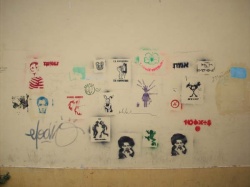
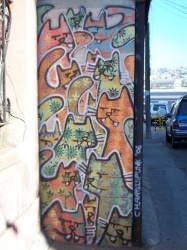
As we admired the murals, we began to recognize the styles of different artists: the cat artist, the artist who did black and white stylized line paintings, the artist who does lots of eyes, and the artists who does figures from odd perspectives.
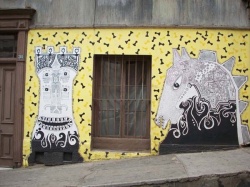
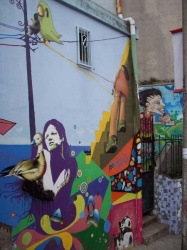
I had to admire the philosophy of the artists who could spend so much time and energy on a piece that once completed was left to the mercies of time: to be covered up, scarred by tags, or sometimes, more interestingly, be added to and altered by other artists. With the last alternative, the work of art seemed to become truly public, a cooperative effort between artists who might not even know each other. The artists also seem to show respect for the historic buildings: mostly the murals seem to end up on dull concrete or abandoned buildings which would otherwise be considered an eye sore.
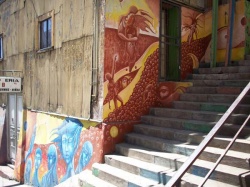
In many places we could see new murals painted over old and some completely reduced to a wall of peeling paint by the weather. The city walls are an ever changing canvas. Maybe in a year this art landscape will be changed completely and the unnamed artists, known only by transient images on walls will be forgotten.
Today we visited the "Open sky museum" a walk around a hill full of commissioned murals, though not without its share of un-commissioned work as well. Here the murals were more abstract with broad swaths of solid color. Some were high on walls (safely out of reach to graffiti artists).
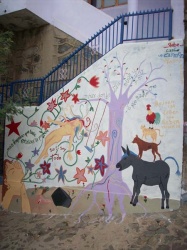
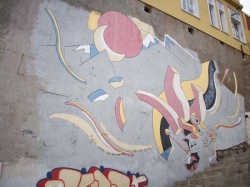
These pieces were more "sophisticated" but I felt they were a bit distant from the life of the streets they were painted in and did not express the vibrancy of the city, as the guerrilla murals did. My favorite piece in the museum was not actually a legit part of it but rather a guerrilla painting of a "bee catcher."

Later a second artist added an angry giant queen bee and other designs, carefully leaving the original painting showing.
We walked around the hill, past Pablo Neruda's house (a museum that was closed on Mondays), passing a very satisfied looking cat.
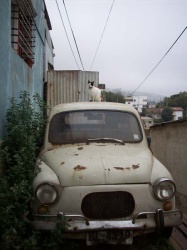
As we were walking back down the hill, we heard drumming on metal. It turned out to be the gas delivery truck with one of the delivery guy drumming on the metal gas containers. I think he was whistling too.
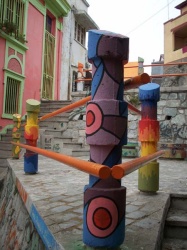

At the bottom of the hill there were some more murals and painted metal poles. The street finished with a little plaza constructed from mosaics.
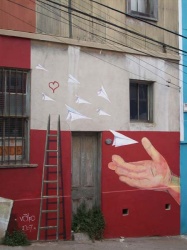
Perhaps some might be offended by the non-historic aspects of the street art, but for me, it really makes the streets special: a contrast between past and present and, in a sense, a quiet introduction of the viewer to the artists who live in the city and what they think, imagine and dream.

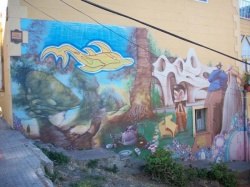
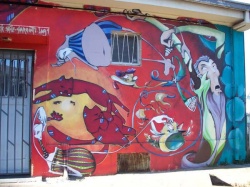
Valparaiso: Head in the clouds and feet on the ground
28 January, 2008, 11:26 am in "Chile"
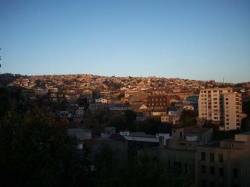 We have our techniques for arriving in a city and getting settled without reservations: Usually we go towards an area with a few hotels listed in LP, or head to the center of town. We find a cafe (have breakfast if arriving early from a night bus) and Rowshan guards the bags while I scout for hotels. This generally works, however, Valparaiso is not set up like the "usual" town. First of all, there isn't really a definite center. Second, most of the budget lodgings are in family run b&b's and no one is up until about 9. Third, the lodging is in residential areas so nothing is open until 9. This is great for people who like to sleep in but bad when you arrive at 6 AM, dazed and bleary from an overnight bus.
We have our techniques for arriving in a city and getting settled without reservations: Usually we go towards an area with a few hotels listed in LP, or head to the center of town. We find a cafe (have breakfast if arriving early from a night bus) and Rowshan guards the bags while I scout for hotels. This generally works, however, Valparaiso is not set up like the "usual" town. First of all, there isn't really a definite center. Second, most of the budget lodgings are in family run b&b's and no one is up until about 9. Third, the lodging is in residential areas so nothing is open until 9. This is great for people who like to sleep in but bad when you arrive at 6 AM, dazed and bleary from an overnight bus.We headed to the hills Concepcion and Alegre, where there seemed to be a concentration of lodging, and found padlocked gates. When a tired voice did answer my phone call, we were told to call back after 9. These are the most difficult times while traveling: you want just 3 things: to eat breakfast, use a toilet, and take a nap. Instead you are forced to find a park bench and wait in the semi-darkness. We found a plaza with benches, one containing a sleeping occupant. The plaza happened to perched on an overlook. We looked over the city at the harbor, listening to the seagulls' morning cries. The seagulls and the view reminded us a bit of Istanbul.
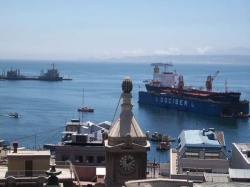
Then the sun slowly began to rise. The scene became gently washed with colors and it was impossible not to be struck by what a beautiful place we were at, high on a hill above the city, with the palace of Belles Artes behind us.
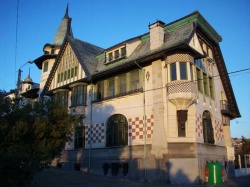
Around 7:30 I decided to do another round of the neighborhood looking for signs of life. Eventually I found a b&b owner who was up and about. By 8:30 I had even found an open cafe. Life is good.
Rowshan and I had breakfast, checked into the B&B and another tough arrival was vanquished. Later, we descended into the lower part of town. This is the other confusing thing about Valparaiso. The town has two parts: the lower part alongside the water and the residential part in the hills above. The hills where we are staying are UNESCO historical sites so I imagine they might be more beautiful than the others which I haven't seen yet. The hill we are on is ethereal--perched above the city; there are cafes, galleries; historic houses with high ceilings, and the smell of fresh baked bread drifting from bakeries.
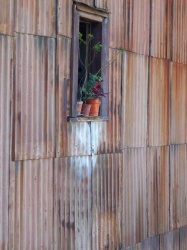
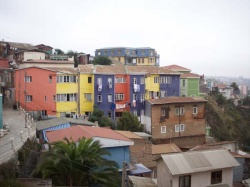
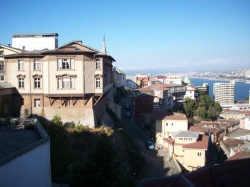
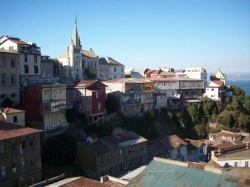
It is a place for enjoying life but in a refined way. Descending to the lower part of the city is a little like leaving the clouds and landing in the dirt. It is a place grayed by car exhaust where even the historic buildings, painted in pastel colors have been dulled. In many places at street level the neo-classical columns and pastel paint have been replaced by large modern glass panes and metal as well as big plastic signs whose bright colors have been shaded by exhaust. The quiet simplicity and the silence of the hills, broken only by seagulls cries is torn asunder by the roars of buses and taxis, the blare of shelves of TVs, rows and rows of cheaply made products, posters screaming out deals and the cacophony of the modern world.
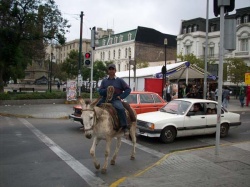
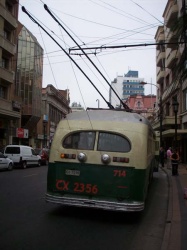
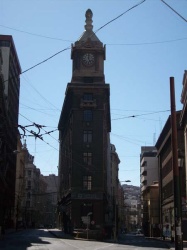
The lower part of town is where the mundane takes over: markets, fast food; stores... In front of the buildings is the port where there is once again a flash of color as the buildings give way to shipping containers, toy cars in a park, and restored buildings on the waterfront.
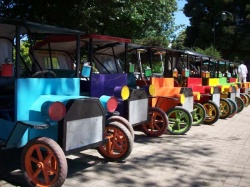
These two worlds are connected in many places by historic "elevators", small funiculars capable of holding about 7 people in each car.
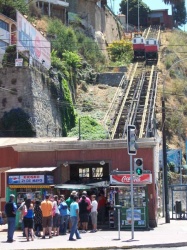
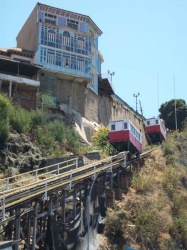
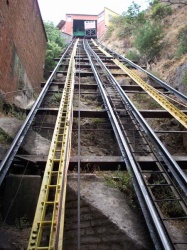
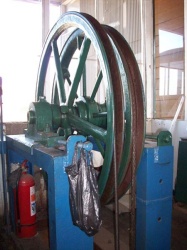
After a lunch of pizza, chicken, french fries, and ice cream, as well as a trip to the station to buy bus tickets, I was already missing the serene elegance of the hills.
Ovalle: Martians and Underpants Gnomes
27 January, 2008, 11:04 am in "Chile"
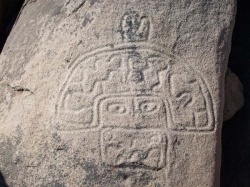 Short on time, and wanting to get a glimpse of Northern Chile, we took a bus this morning to Ovalle, a small city surrounded by farms and vineyards which disappear into hot, dry desert hills. The main reason we chose Ovalle was there was a ceramics museum for Rowshan, a cloud forest a couple hours away for me and some petroglyphs. Due to the shortage of time and lack of public transportation to the cloud forest, we eliminated that early on.
Short on time, and wanting to get a glimpse of Northern Chile, we took a bus this morning to Ovalle, a small city surrounded by farms and vineyards which disappear into hot, dry desert hills. The main reason we chose Ovalle was there was a ceramics museum for Rowshan, a cloud forest a couple hours away for me and some petroglyphs. Due to the shortage of time and lack of public transportation to the cloud forest, we eliminated that early on.As we arrived into town, we both were equally unimpressed so decided to just visit the museum and petroglyphs and then take a midnight bus to Valparaiso. We managed to find the museum only to learn it was only open Tuesday through Friday meaning it was closed and would be for the next 2 days. We went back to the bus station to catch a Santiago bound bus back 19 km to the road to the petroglyphs. Unfortunately, the next bus was at 6PM so we had to take a taxi. This proved to be a good thing since the road to the petroglyphs had no shade and the weather was sizzling. As we were driving out of town we passed multicolored gypsy tents.
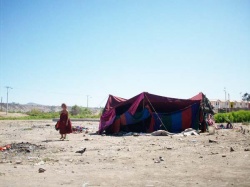
We'd passed some others earlier during the bus ride but I wasn't sure they were Roma because they looked like small circus tents with their festive bright colors. As we drove to the site, we discussed life in Chile and politics of the US with the taxi driver.
At the site we were handed over to the ticket and general info guy who immediately asked us "Bush or Clinton?" To which we replied Clinton. Then he asked, "Reagan or Carter?" He gave us a quick intro: "Here is the trail, the petroglyphs are marked with white arrows. Down there is the Martian." He gestured with his fingers like antennae over his head. I felt bad turning down the offer of a tour guide since the guide looked kind of dejected when we did. He resembled Roberto Benigni.
We walked down into the Valle del Encanto and followed the signs to the petroglyphs. There were often faint and hard to make out. But then they were supposed to have been created by a culture from 2000 years ago. There were a few clearer ones including the "martian." The info office had a cartoon version titled, "Man with television head."
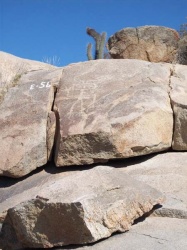
The area was hot and dry with cactus and large boulders.
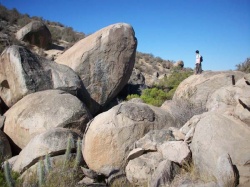
There were several areas with grinding stone holes as well as some pictographs which were fainter than the petroglyphs.
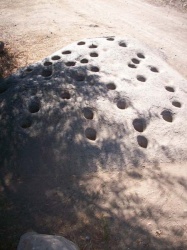
There were also a couple shelters. The petroglyphs were spread out and we had to follow footpaths made by other tourists, some leading nowhere, others leading to a petroglyph. There were murky algae filled pools between some of the rocks as well as an area signed, "Incan Baths." Our deal with the taxi driver was he'd wait an hour for us (not that he'd leave since we hadn't paid him). We rushed about trying to make sure we didn't miss anything. There were strange stick figures, square heads with antennae and heads with what looked like sun rays. There were also a couple stick figures holding what looked like a pair of underwear between them... Could they have been ancient underwear gnomes?
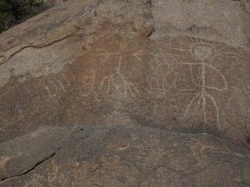
Apparently it is easier to see the petroglyphs when the sun is directly overhead. I wonder what inspired them: futuristic premonitions of 1950s alien invasion movies?
Back in town we hung out in a cafe. As it got dark, the Plaza de Armas was lit up with Christmas lights on a giant evergreen tree in the center. Surrounding the evergreen were huge palm trees also decorated with Christmas lights.
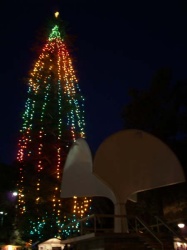
Powered by My Blog 1.69. Copyright 2003-2006 FuzzyMonkey.net.
Created by the scripting wizards at FuzzyMonkey.net..
(Code modified by Rowshan Dowlatabadi)
Created by the scripting wizards at FuzzyMonkey.net..
(Code modified by Rowshan Dowlatabadi)

